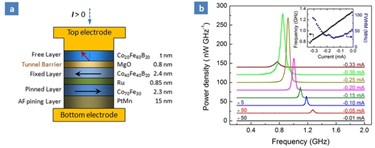SINANO Led Research Team Develops Ultrahigh Sensitivity Nanoscale Microwave Detectors

By ZENG Zhongming
By using innovative magnetic materials, researchers from the Suzhou Institute of Nano-tech and Nano-bionics (SINANO), Chinese Academy of Sciences, the University of California at Los Angeles (UCLA), and the University of Messina (Italy) have made a breakthrough in the development of microwave detectors – devices that can sense weak microwave signals used for mobile communications, radars, and other applications. The team’s developed detectors are compact and provide record-high sensitivity. They are known as spin-torque microwave detectors (STMDs), as they use the spin of electrons to detect microwave signals, unlike existing detectors which use the electron charge. The SINANO team's improved detector has great potential to be used in future telecommunications, sensor networks, and internet of things.
The STMD’s core component is composed of two distinct magnetic layers. One layer has a reference direction, meaning that its north and south magnetic poles are fixed in space. The other layer's magnetic direction can change in response to a microwave current flowing through it. This allows the structure to produce a voltage in response to an external microwave signal. The STMD's key advantage over existing technologies is that it can combine large detection sensitivity at low input power, so it can detect even very weak signals. It also combines energy-efficiency with nanoscale size.
To date, however, the detection sensitivity of STMDs has mainly relied on the application of external magnetic fields, which hinders their implementation for practical applications, necessitating the use of bulky permanent magnet.
By using magnetic layers with perpendicular magnetic anisotropy – similar to those used in spin-transfer torque magnetic memory (STT-MRAM) – the SINANO team demonstrated a record-high detection sensitivity at room temperature without any external bias fields, and for low input power (micro-Watts or lower). The sensitivity is 20× larger than state-of-the-art Schottky diode detectors In addition, this eliminates the need to move large numbers of electrons through wires, and also eliminates the need for permanent magnets or conducting coils to provide the bias magnetic field, thus significantly saving both energy and space. STMD devices can be scaled down to nano-meter size (0.07 μm2 in the study), which makes them potentially suitable for compact on-chip microwave detectors.
"Previously, there had been no demonstration of an STMD with sufficiently high detection sensitivity at low-input power, and simultaneously without the need for an external magnetic field, hence preventing practical applications," said the lead researcher ZENG Zhongming, SINANO professor at the SINANO Nanofabrication Facility. "We have realized all these requirements in a single device."
"The ability to highly sense for an ultralow microwave signal in zero magnetic field is exciting for wireless applications. This work presents a new route for the development of the next-generation of on-chip microwave detectors." said co-author G. Finocchio, who is an assistant professor at the University of Messina, Italy.
"Emerging spintronic devices have the potential to transform the electronics industry, enabling dramatic improvements in energy efficiency and performance. An immediate example is the fast-growing area of nonvolatile magnetic memory (MRAM). This work shows that spintronic devices may also provide practical value in a different class of applications, namely nanoscale microwave detectors," said Pedram Khalili, an adjunct assistant professor at UCLA and co-author of the paper. "These devices can be integrated within CMOS back-end manufacturing processes, potentially enabling their integration in systems on a chip."
The paper, "Giant spin-torque diode sensitivity in the absence of bias magnetic field" has been published online in the journal Nature Communications.
Other key authors included Bin Fang, a Ph. D student at SINANO, Mario Carentieri professor of electrical engineering at Politecnico of Bari (Italy), Hongwen Jiang, UCLA professor of physics and astronomy, Kang L. Wang, UCLA Engineering's Raytheon Professor of Electrical Engineering and director of the Western Institute of Nanoelectronics (WIN) and Baoshun Zhang, SINANO professor and director of the SINANO Nanofabrication Facility .
This work was supported by the National Science Foundation of China (11274343, 11474311) and the National key foundation for exploring scientific instrument of China (2011YQ120053), the DARPA STT-RAM and Non-Volatile Logic programs, and the Nanoelectronics Research Initiative (NRI) through the Western Institute of Nanoelectronics (WIN). The work at UCLA was also supported in part by the NSF Nanosystems Engineering Research Center for Translational Applications of Nanoscale Multiferroic Systems (TANMS). This work was also supported by the project PRIN2010ECA8P3 from Italian MIUR and NSF support through grants DMR-1210850, DMR-1124601 and ECCS-1309416. Other authors included researchers from the University of California at Los Angeles and Irvine, and Singulus Technologies of Germany.
Original Release: http://english.sinano.cas.cn/rh/rp/201604/t20160411_161725.html
Source: Suzhou Institute of Nano-Tech and Nano-Bionics (SINANO)
